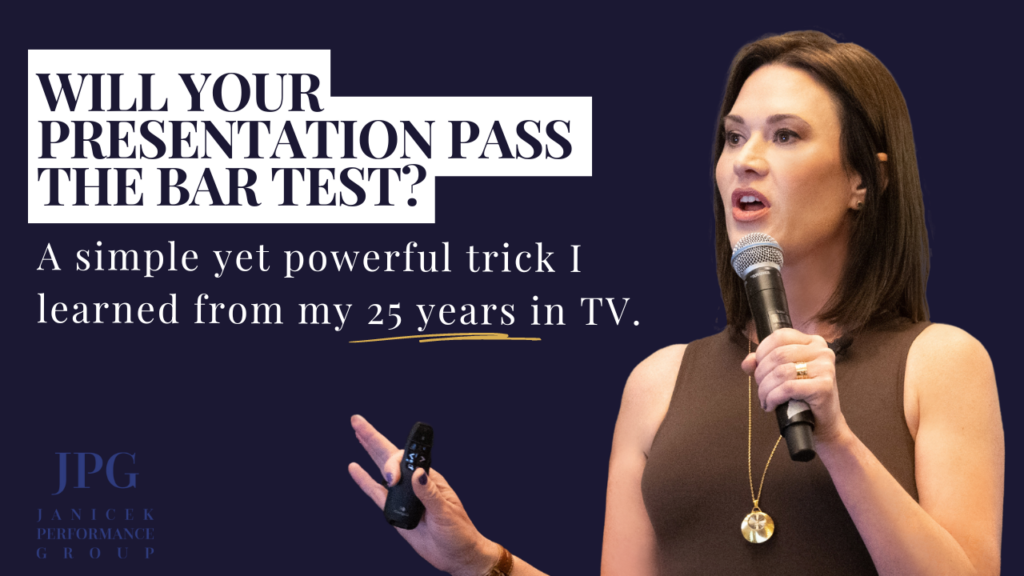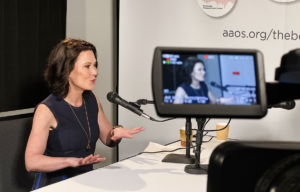Picture this: You’re in a crowded bar. The TVs are all tuned to the local news, but there’s no sound. The bartender is talking to customers, the clinking of glasses fills the room, and you can barely hear your own thoughts. Despite all this, you still glance at the TV and instantly understand what’s being shown on screen.
That’s exactly how your audience should feel when they look at your presentation slides.
I call it the “Bar Test,” a concept I picked up from my 25 years in TV. In local television, we had one big rule: our graphics had to be instantly understood, even if someone was watching from across the room, without sound, in a noisy environment like a bar. And you guessed it: that same rule applies to your presentation.
Step Into Your Audience’s Shoes
When you’re creating a presentation, it’s easy to focus on the message you want to deliver, but it’s more important to think about how your audience will receive it. Are your slides easy to digest? Will your message land with everyone in the room—even the person sitting farthest from the screen?
That’s why the Bar Test is so critical. Imagine your audience in different settings: the back row of a large conference hall, a distracted colleague who’s checking emails while you’re presenting, or even someone with less-than-perfect vision. Can they still easily grasp your message from your slides?
Here’s how to ensure your slide deck passes the Bar Test:
1. One Slide, One Message
Every slide in your presentation should tell a single, clear story. If you’re trying to cram multiple points into one slide, you’ll lose your audience. Keep it simple. One slide, one message. This way, even if someone glances at it for just a few seconds, they’ll get it.
Think of each slide as a quick snapshot of what you’re saying. You don’t need to tell every detail on a single slide—that’s what your voice is for! Let your slides support you, not overload your audience.
2. Create Visual Contrast
Good design is key. Strong visuals will help your audience understand your message at a glance, but poor design will distract and confuse them. High contrast between your text and background is a must. Dark text on a light background or vice versa—keep it bold and clear.
Imagine your audience looking at your slides from the back of a room or a boardroom where the lighting isn’t great. Will they be able to read it? If they can’t, your message is lost.
3. Go BIG with Your Fonts
Tiny fonts are the silent killer of effective presentations. They might look fine on your computer screen, but in a large room, small fonts become unreadable. Be generous with your font size—your audience will thank you.
Ask yourself, “Can someone sitting 20 feet away still read this?” If the answer is no, it’s time to increase your font size. Big fonts equal a big impact.
4. Clear, Instant Message
Have you ever seen a slide with so much information on it that you didn’t know where to start? That’s what you want to avoid. Every slide should communicate a single idea or concept—and that idea should be crystal clear.
Your audience should know what you’re trying to say the moment they lay eyes on the slide. Don’t make them search for the point. If it takes more than a glance to understand, it’s time to simplify.
How to Make Your Slides Pass the Bar Test
Before your next presentation, I challenge you to go through every slide and ask yourself: Can this pass the Bar Test? Can my audience quickly understand the message on this slide, even if they’re distracted or sitting far away? If not, refine it.
Here’s how to do it:
- Look at each slide as if you’re a member of the audience.
- Consider how your message looks from every angle: Are the colors working? Are the fonts readable? Is it cluttered, or is it clear?
- Don’t overwhelm with too much information. Keep it focused, and remember that your slide is a just visual aid—not the entire presentation.
The Power of Simplicity
You might feel tempted to pack your slides with details, but trust me—the simpler, the better. Your audience will appreciate clean, easy-to-follow visuals that help them stay engaged with your words. Simplicity breeds clarity, and clarity leads to impact.
I’ve used the Bar Test for years, both in TV and now at Janicek Performance Group, where I coach professionals on presentation skills. I’ve seen firsthand how a clear, well-designed presentation can capture an audience’s attention and help you make your point with confidence.
At the end of the day, it’s not just about the information you’re sharing; it’s about how well your audience can receive it. Put yourself in their shoes. Make sure they can grasp your message without having to work for it.
Whether you’re presenting to a crowded room of executives or your team at a meeting, applying the Bar Test will help you deliver with impact.
At Janicek Performance Group, we specialize in helping you fine-tune your presentations, keynotes, media interviews, and make your message crystal clear. Let us help you make sure your slides pass the test, so you can focus on what matters—delivering your message with confidence.





